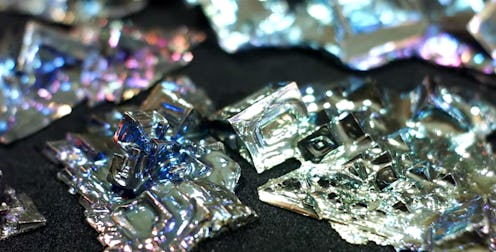
I am not only a fan of DIY science experiments, but more important, I am a big fan of shiny things. You know how hunters lure raccoons to their deaths? Basically what happens is they put a shiny object in a trap that a raccoon could easily escape if they unclenched their fists and let the shiny thing go. The trouble is, they won't. They just love shiny things too damn much, and so, they will sit there and die for them, a problem I can wholly relate to. Shiny things are the greatest. So yeah, it might not seem like there would be a very pressing reason to make your own bismuth crystals on the stove, but that's probably because you're a lot saner than I am.
Here's the thing about making bismuth crystals: You can feel 90% less vain about the whole thing, because even though you're just doing it to put random glam in your life, there's all sorts of science involved. Basically you get to be Marie Curie for five minutes, so pat yourself on the back, you scientific genius, you.
Before you start, you should be wearing a pair of safety goggles and leather gloves. Otherwise, how will your roommates know that you're doing Science? Also, burns are lame, so it's nice to protect against them. Besides that, all you need is a sauce pan that you have no emotional attachment to (it will be ugly forever after this), and five pounds of bismuth metal, which you can buy on Amazon, like literally everything else in the universe.
With your bismuth metal at the ready, stick it in a sauce pan and melt it down. It should start to look like this:
Once it's fully melted, turn off the heat source. It takes a long time to cool, but you can skim off the oxides that rise to the top while you wait.
After the bismuth starts to cool down, crystals will form at the top and grow downward. You're supposed to poke at them a little bit as they grow so they don't get stuck to the bottom of the pan. When you feel them start to touch it the bottom, that's when it's time to pull them up.
At first, they'll be just silver, but then the color will change depending on the temperature of the metal when it first makes contact with oxygen.
But if you don't like the color you get, you can just as easily melt the whole thing all over and try again. It's an endless cycle of bismuth amusement!!
Images: YouTube (7)